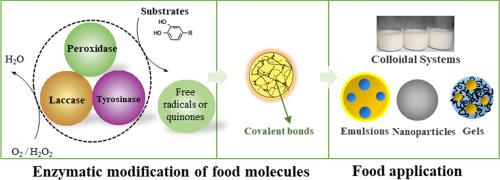Trends in Food Science & Technology ( IF 15.1 ) Pub Date : 2020-06-23 , DOI: 10.1016/j.tifs.2020.06.014 Xueqi Li , Siqi Li , Xiuping Liang , David Julian McClements , Xuebo Liu , Fuguo Liu

|
Background
Improving the quality attributes and nutritional profiles of functional foods has been a major focus of research in recent years. Enzymatic modification of food molecules can be used to enhance their functional performance in foods. Laccase, peroxidase, and tyrosinase can catalyze the oxidation of proteins, polysaccharides, and polyphenols, and have great application potential in the construction of food colloids.
Scope and approach
This review summarizes and compares the catalytic mechanisms of laccase, peroxidase, and tyrosinase for the modification of food molecules and their applications in colloidal systems, as well as highlighting the advantages of combining different oxidases.
Key findings and conclusions
Laccase, peroxidase and tyrosinase catalyze the oxidation of food molecules in two steps. The first step involves an enzymatic reaction to generate free radicals or quinones; the second step involves a non-enzymatic reaction of free radicals or quinones with other molecules. Enzymes mainly play a role in initiating reactions in the whole process, which generally requires the participation of phenolic substances. In addition, polysaccharides and proteins containing phenolic groups can also be directly cross-linked. Peroxidase seems to have the most extensive catalytic substrates among the three oxidases reviewed. The cross-linking of food molecules induced by these oxidases helps to improve the formation and stability of colloidal systems, such as emulsions, nanoparticles, and microgels, thereby enhancing their potential for encapsulating, protecting, and delivering bioactive compounds. Employing a combination of different oxidases in food colloids can overcome the limitations of single oxidase and improve the functionality of the overall system.
中文翻译:

氧化酶在食品分子和胶体系统修饰中的应用:漆酶,过氧化物酶和酪氨酸酶
背景
近年来,改善功能食品的质量属性和营养状况一直是研究的主要重点。食品分子的酶促修饰可用于增强其在食品中的功能性能。漆酶,过氧化物酶和酪氨酸酶可以催化蛋白质,多糖和多酚的氧化,在食品胶体的构建中具有很大的应用潜力。
范围和方法
这篇综述总结并比较了漆酶,过氧化物酶和酪氨酸酶对食物分子的修饰及其在胶体体系中的应用的催化机理,并强调了组合不同氧化酶的优势。
主要发现和结论
漆酶,过氧化物酶和酪氨酸酶分两个步骤催化食物分子的氧化。第一步涉及酶促反应以产生自由基或醌。第二步涉及自由基或醌与其他分子的非酶促反应。在整个过程中,酶主要在引发反应中起作用,这通常需要酚类物质的参与。此外,含有酚基的多糖和蛋白质也可以直接交联。在所审查的三种氧化酶中,过氧化物酶似乎具有最广泛的催化底物。这些氧化酶诱导的食物分子的交联有助于改善胶体系统(例如乳液,纳米颗粒和微凝胶)的形成和稳定性,从而增强其封装潜力,保护和传递生物活性化合物。在食品胶体中采用不同氧化酶的组合可以克服单一氧化酶的局限性,并改善整个系统的功能。











































 京公网安备 11010802027423号
京公网安备 11010802027423号